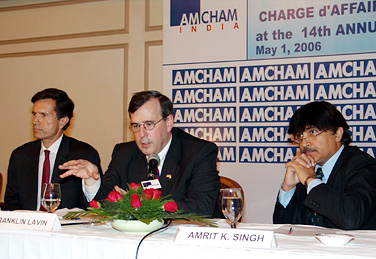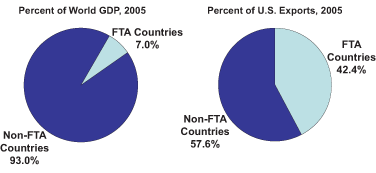|
|
|
||||||||
|
Short Takes: News from the International Trade Administration Visit to India by Under Secretary Lavin Marks Continued Progress in Trade Relations On May 2, 2006, Under Secretary of Commerce for International Trade Franklin L. Lavin met with Indian Commerce Secretary S. N. Menon in New Delhi to launch the renewed Commercial Dialogue between India and the United States. Originally established in 2000, the Commercial Dialogue serves as a mechanism for fostering discussion and addressing trade disputes between the two countries. The meeting took place because of a commitment made during President George W. Bush’s February 2006 visit to India. (See the related article in the April 2006 International Trade Update.) The Commercial Dialogue will involve the private sector in addressing bilateral trade issues; foster progress in functional, cross-cutting areas, such as intellectual property rights and trade remedies; and refocus existing work on standards to address sectoral topics. “This elevated engagement marks recognition of the improving climate for business in India,” remarked Lavin. “I would like to explore a roundtable on pharmaceuticals and a business mission under the aegis of the Commercial Dialogue.” While in New Delhi, Lavin also spoke to the American Chamber of Commerce in India. He later made a stop in Mumbai, where he announced the opening of a new commercial post in Calcutta and the appointment of commercial attachés for intellectual property and civil aviation. In June, an Indian trade delegation is scheduled to meet in Washington, D.C., to continue work on the Commercial Dialogue.
Regulatory Guide to Sales of Pre-owned Medical Devices Published World markets are important for used equipment, such as clothing, automobiles, and medical equipment. But some of the most basic facts about those markets, such as their size, the best ones, and the national laws and regulations that affect such trade, are either nonexistent or difficult to find. In an effort to help U.S. exporters in the used medical devices market, the U.S. Department of Commerce compiles and periodically publishes a comprehensive listing of regulations governing this important and growing trade. On May 15, 2006, the sixth edition of Global Import Regulations for Pre-owned (Used and Refurbished) Medical Devices was published. The report is based on information from the International Trade Administration’s worldwide network of in-country commercial analysts, and it offers detailed country-by-country entries for 105 markets. Each entry includes an in-depth discussion of the regulatory environment for imports of used medical equipment. Also noted are related topics—such as sanitary codes, customs valuations, and taxes—that may affect trade in used medical devices. Most market entries include lists of government and trade association contacts. Copies of the report are available for downloading as a PDF document from the International Trade Administration’s Web site. New Web Service Aids Tracking of Changing Foreign Technical Regulations Want to know about pending changes in technical regulations in Brazil, South Korea, the United Kingdom, or any of the 148 nations that are members of the World Trade Organization (WTO)? Then sign up for ” Notify U.S., ” a service that was unveiled by the National Institute of Standards and Technology (NIST). Notify U.S. is the successor to “Export Alert!,” the e-mail regulations notification system previously offered by NIST and the International Trade Administration. The new Web-based service offers a fast, comprehensive, global perspective on proposed technical regulations and conformity assessment procedures that might influence U.S. access to export markets. Notify U.S. provides users with access to notifications and to full texts of regulations issued by WTO members. In addition, users can monitor proposed changes across chosen countries and 41 fields of industrial or technical activities. They can also select a subset of fields. Users will receive e-mail messages informing them when proposed regulations are issued by countries or by fields of technical activity. This new, free service is operated by NIST’s National Center for Standards and Certification Information (NCSCI). NCSCI is the nation’s designated “inquiry point” under the WTO Agreement on Technical Barriers to Trade. At the request of Notify U.S. users, NCSCI will secure the full text of a proposed regulation referenced in a notification. To learn more—and to sign up—go to the Notify U.S. Web site. New Web Site Offers Guide to Electric Current Worldwide Electric Current Abroad, a comprehensive guide to the many types of electrical current and hardware used around the world, has just been updated and released again as a Web site, Electric Current Worldwide. The print version of this popular reference resource has been published by the International Trade Administration since 1948 and was last updated in 1998. For the 217 countries in the new publication, Electric Current Worldwide includes the following information: • Listings of phases, voltage, wiring, frequencies, and much more, with regional variations noted • Maps showing the distribution of current and wiring variations • Photos and drawings of known plug and socket types • A link to the Central Intelligence Agency’s World Factbook entry for each country For many years, the guide has proven to be a valuable resource for manufacturers and exporters of electrical devices and equipment, as well as for international travelers. The new edition is available online. World Trade Week 2006 Calling free and fair trade, “a powerful engine for growth and job creation in the United States and in countries throughout the world,” President George W. Bush officially proclaimed World Trade Week 2006 in an announcement released by the White House on May 19. World Trade Week is being observed this year from May 21 through 27. It was first observed in 1935, with a proclamation from President Franklin D. Roosevelt. In his statement, President Bush noted the administration’s support of expanded free trade. “Since 2001,” he said, “my administration has concluded or implemented free trade agreements with 15 countries. We are working toward agreements with 14 additional countries, and we will continue to pursue further opportunities.” Public events in observation of World Trade Week—including meetings, trade shows, and educational seminars—are scheduled throughout the country. For more information, go to www.worldtradeweek.com. Trade Numbers: Exporting—There Is Room to Grow U.S. Free Trade Agreement Partners in the Global Economy World GDP excludes the United States. GDP percentage shares are based on GDP figure on a Purchasing Power Parity (PPP) basis. Export figures are for U.S. total exports. FTA countires include all countries with free trade agreements, effictive through 2005 (Australia, Canada, Chile, Israel, Jordan, Mexico, and Singapore).
|
|

